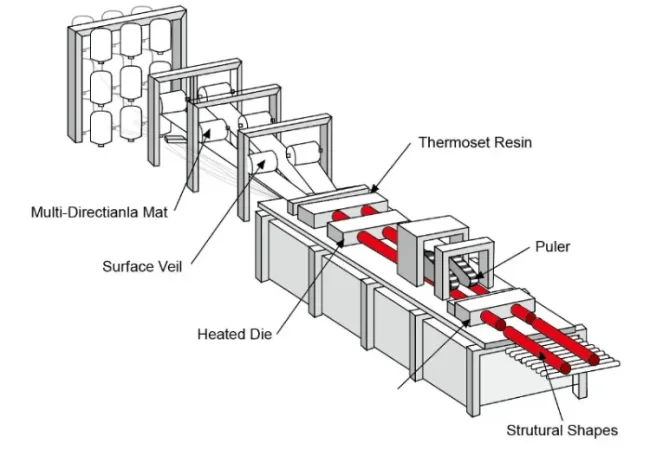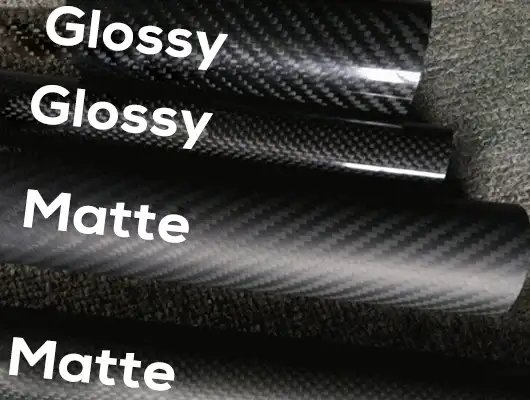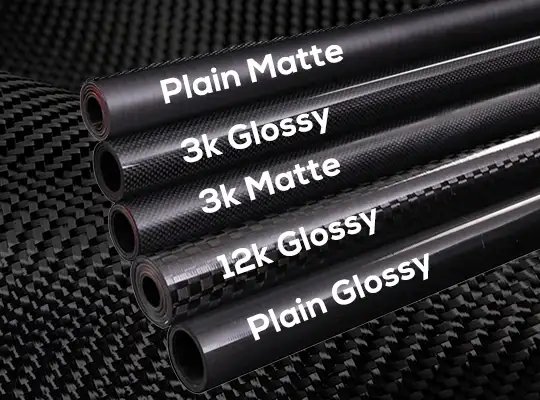
FINDEN SIE IHREN ZUVERLÄSSIGEN HERSTELLER VON KOHLEFASERSTÄBEN

Pultrusionsverfahren
Die Fasern werden durch ein Harzbad gezogen, das eine gleichmäßige Imprägnierung gewährleistet, und das Faser-Harz-Gemisch durchläuft eine beheizte Matrize, um die gewünschte Stangenform zu erhalten, die während der Bewegung durch die Matrize kontinuierlich aushärtet.

Anpassbar
Nicht nur die Länge und der Durchmesser, sondern auch alle anderen Aspekte können individuell angepasst werden, einschließlich der Fasern, der Oberflächenbeschaffenheit (matt, glänzend), der Güteklassen (T300, T700, T800) und der Formgebung.

Lösung aus einer Hand
Mit unserer CNC-Maschine wird der pultrudierte Kohlefaserstab, nachdem er die Formgebungs- und Kühlzonen durchlaufen hat, mit einer Säge oder einem anderen Schneidwerkzeug auf die gewünschte Länge zugeschnitten.

Länge und Durchmesser
Die Länge und Durchmesser eines Kohlefaserstab kann je nach Anwendungsbedarf angepasst werden. Hier ist eine Aufschlüsselung:
1. Länge
- Die Standardlängen reichen in der Regel von 500mm bis 3000mm (0,5m bis 3m).
- Sonderlängen können je nach Bedarf hergestellt werden.
- Einige Hersteller bieten Endloslängen für spezielle Anwendungen an.
2. Durchmesser
- Gängige Durchmesser reichen von 0,5 mm bis 50 mm oder mehr.
- Für Präzisionsanwendungen sind Mikrostangen (unter 1 mm Durchmesser) erhältlich.
- Für Anwendungen mit hoher Belastung können Stangen mit großem Durchmesser (über 50 mm) hergestellt werden.
Da Kohlefaserstäbe anpassbarDie genaue Länge und der Durchmesser können je nach Stärke, Gewicht und benötigter Leistung angepasst werden. Lassen Sie mich wissen, wenn Sie mehr Details benötigen!

Weben
Für die äußere Schicht können Sie zwischen verschiedenen Bindungsarten wählen, um Ihre mechanischen Anforderungen zu erfüllen und den Kohlefaserrohren gleichzeitig ein attraktives Aussehen zu verleihen.
- Twill-Gewebe
- Leinwandbindung
- UD (Unidirektional)

Oberflächenveredelung
Es gibt sie auch in verschiedenen Ausführungen, darunter glänzend und matt. Glänzende Carbonfasern haben eine glatte, reflektierende Oberfläche, die ein glattes und glänzendes Aussehen verleiht. Matte Carbonfasern haben eine nicht reflektierende Oberfläche mit einem weicheren, gedämpften Finish.
- Glänzend
- Halbmatt
- Matt

Kohlefaser-Schleppen
"K" steht für eintausend und gibt die Anzahl der Fasern in jedem Bündel an. Je größer die Zahl, desto breiter ist das Bündel, was auch zu Unterschieden im Aussehen führt.
- 1K
- 3K (am häufigsten)
- 6K
- 12K

Kohlefaser Festigkeitsklasse
Wir wissen, dass verschiedene Anwendungen unterschiedliche Leistungsniveaus erfordern. Deshalb bieten wir 3 der gängigsten Kohlefaserqualitäten an, um Ihre spezifischen Anforderungen zu erfüllen
- T300 (meist verbreitet)
- T700
- T800
Was ist ein Kohlenstofffaserstab?
Kohlefaserstäbe gehören zu den begehrtesten Verbundwerkstoffen in der Konstruktion, Fertigung und bei leistungsorientierten Anwendungen. Stärker als Stahl, leichter als Aluminium und verschleißfest, lösen diese fortschrittlichen Stäbe Herausforderungen, bei denen herkömmliche Materialien versagen. Aber was macht sie so einzigartig? Wie können sie Alternativen übertreffen? Lassen Sie uns die Details so aufschlüsseln, dass sie für diejenigen von Bedeutung sind, die Haltbarkeit, Präzision und Effizienz suchen.
Ein Kohlenstofffaserstab besteht aus dicht gepackten Kohlenstofffasern, die mit einer Polymermatrix verschmolzen sind. Diese Verschmelzung sorgt für eine unübertroffene Zugfestigkeit, außergewöhnliche Steifigkeit und beeindruckende Ermüdungsbeständigkeit. Im Gegensatz zu Metall oder Holz sind Verbundwerkstoffstangen unempfindlich gegen Korrosion, Feuchtigkeit und Umwelteinflüsse. Die Anwendungen reichen von der Luft- und Raumfahrt bis hin zu Sportgeräten, Industrieautomation und Strukturverstärkung.
Warum sollten Sie Kohlenstofffaserstäbe anderen Materialien vorziehen?
Leicht und doch stark - Pfund für Pfund übertreffen diese Stäbe die Festigkeit von Stahl, wiegen aber nur einen Bruchteil davon.
Korrosionsbeständig - Im Gegensatz zu Metallen rostet und verzieht sich Kohlefaser nicht und wird in feuchten, salzigen oder chemisch belasteten Umgebungen nicht schwächer.
Außergewöhnliche Steifigkeit - Die hohe Steifigkeit gewährleistet Präzision und minimale Durchbiegung, wodurch sie sich ideal für Robotik, Automatisierung und Präzisionswerkzeuge eignen.
Langlebigkeit unter extremen Bedingungen - Hitze, Kälte und Druckschwankungen beeinträchtigen ihre Integrität kaum.
Minimale thermische Ausdehnung - Diese Stäbe behalten ihre Form und Festigkeit auch bei schwankenden Temperaturen.
Praktische Anwendungen von Kohlefaserstäben
Von Spitzenindustrien bis hin zu alltäglichen Anwendungen liefern diese Verbundwerkstoffstangen unübertroffene Leistungen. Einige wichtige Beispiele sind:
Luft- und Raumfahrt - Strukturelle Stützen, leichte Rahmenwerke, UAV-Komponenten.
Automobilindustrie - Fahrwerksverstärkungen, Rennsportmodifikationen, gewichtssparende Upgrades.
Sport und Freizeit - Angelruten, Drachen, Bogenschießausrüstung, Sportfahrräder.
Bauwesen und Architektur - Betonbewehrung, Strukturträger, Brückenstützen.
Medizin und Prothetik - Leichte orthopädische Hilfsmittel, Rehabilitationsmittel, chirurgische Instrumente.
Auswahl des richtigen Kohlefaserstabs
Da es verschiedene Größen, Faserausrichtungen und Harzsysteme gibt, muss man bei der Wahl des idealen Stabes die Projektanforderungen kennen. Berücksichtigen Sie diese kritischen Faktoren:
1. Die Ausrichtung der Fasern ist wichtig
Unidirektionale Stäbe - Maximale Steifigkeit entlang einer einzigen Achse, ideal für strukturelle Anwendungen, die eine hohe Zugfestigkeit erfordern.
Pultrudierte Kohlefaserstäbe - Die gleichmäßige Ausrichtung der Fasern sorgt für erstklassige mechanische Eigenschaften, was sie für tragende Anwendungen geeignet macht.
gewebt oder geflochten - Erhöhte Flexibilität und Stoßfestigkeit, oft für dynamische Bewegungen oder Sportgeräte gewählt.
2. Das Harzsystem bestimmt die Leistung
Epoxidharzbasis - Bietet überragende Festigkeit und Langlebigkeit und wird häufig in Hochleistungsanwendungen eingesetzt.
Vinylester - Es ist erschwinglicher und bietet eine gute Beständigkeit gegen Umwelteinflüsse.
Phenolisch - Hitzebeständig und für feuersichere Anwendungen geeignet.
3. Durchmesser und Wanddicke bestimmen die Festigkeit
Dickere Stangen können höhere Lasten bewältigen, aber unnötiges Gewicht kann die Effizienz verringern. Die Ingenieure optimieren die Dicke für maximale Festigkeit bei minimalem Gewicht.
Häufige Probleme und deren Lösung durch Carbonfaserstäbe
Problem: Gewichtsbeschränkungen
Herkömmliche Materialien wie Stahl und Aluminium erhöhen das Systemgewicht und verringern die Effizienz. Lösung: Kohlefaserstäbe erhalten die Festigkeit ohne übermäßige Masse, was zu Energieeinsparungen und besserer Leistung führt.
Problem: Korrosion und Degradation
Metall wird im Laufe der Zeit durch Rost, Belichtung und Abnutzung schwächer. Lösung: Die Stäbe aus Verbundwerkstoff widerstehen rauen Bedingungen, ohne sich zu verschlechtern, und gewährleisten so langfristige Zuverlässigkeit.
Problem: Flex und strukturelle Instabilität
Holz oder Kunststoff können sich unter Belastung unvorhersehbar verbiegen, was zum Versagen führen kann. Lösung: Kohlefaserstäbe bieten berechenbare Steifigkeit und gleichbleibende Leistung.
Bei der Wahl des richtigen Kohlefaserstabs müssen die Faserausrichtung, die Harzart und der Durchmesser für die jeweilige Aufgabe berücksichtigt werden. Ob bei der Verstärkung eines Hochgeschwindigkeitsfahrzeugs, der Konstruktion eines leichten Roboterarms oder der Herstellung von Hochleistungssportgeräten - Kohlefaserstäbe sind das ultimative Material. Sie ersetzen veraltete Alternativen, lösen kritische technische Herausforderungen und bringen die Industrie zu stärkeren, effizienteren Lösungen.
Erkunden Sie die verfügbaren Optionen, stimmen Sie die Spezifikationen auf die Projektanforderungen ab und erleben Sie die Vorteile modernster Verbundwerkstoffe aus erster Hand.
